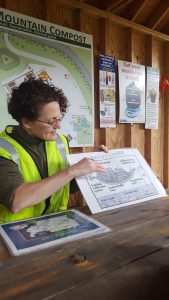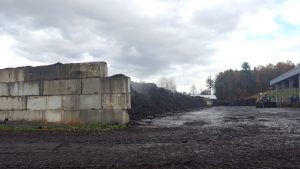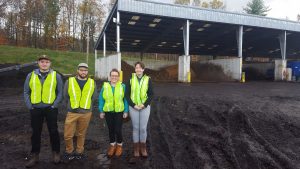This post was written by Sarah Healey ’18
 The Net Impact Graduate Chapter at the University of Vermont is designed to supplement learning experiences for students in the Sustainable Innovation MBA program. For our first event of the year a number of chapter members took a field trip to the Green Mountain Compost Facility in Williston, Vt..
The Net Impact Graduate Chapter at the University of Vermont is designed to supplement learning experiences for students in the Sustainable Innovation MBA program. For our first event of the year a number of chapter members took a field trip to the Green Mountain Compost Facility in Williston, Vt..
At the facility we got a lesson and a tour from Robin Orr, the Events and Hospitality Outreach Coordinator for the Chittenden Solid Waste District (CSWD).
How much are we throwing away?
Every year Vermonters send 4,000 truckloads of trash to the only landfill in the state. Approximately half of this trash is actually trash. The other half consists of items that could have been diverted either to a recycling facility or a compost facility.
 How do we divert food waste?
How do we divert food waste?
During our trip we learned about the Vermont law that prohibits food scraps from being put in the landfill. This law is often referred to as the “universal composting law.” The law prohibits food scraps from being put in landfills. But not all food scraps need to be composted. At Green Mountain Compost they have three stages they encourage people and businesses to go through before sending their scraps to the compost facility. First, they recommend producing fewer scraps. Second, they help put people with excess food in contact with people in need of food. Third, they suggest feeding the food scraps to livestock, such as pigs. Once all of these resources are exhausted then the food should be composted.
So what can be composted?
There are strict regulations on what can and cannot be composted and what compost can be labeled as organic. These regulations limit what compost facilities will take. Green Mountain Compost is one of the more inclusive compost facilities in Vermont. They take regular food scraps, 100% fiber, bioplastics, napkins, paper towels, certified compostable items, and more. As a result not all of their compost can be labeled as organic. .
 How does it work?
How does it work?
At this facility they use a scale to measure the amount of food scraps being brought in. These scraps are then dumped in first section of the facility and covered with a layer of woodchips to prevent smells and parasites. The compost is then put through a machine that acts like a giant food processor. This process breaks up big chunks of food, making the composting processes faster. The compost is then moved to the next section where it is carefully monitored for temperature and oxygen levels. Once the compost is moved to the next section it is brought up to between 140 to 170 degrees for 72 hours. This kills all known pathogens that could be in the compost, but allows the good bacteria, that breaks down food, to flourish. At various stages the compost is sorted to weed out items, such as silverware, that get caught in the mix. The final step that the facility takes is to let the compost cure. This stage is something that not all compost facilities do. Once it is official compost it is tested and sent to the stores!
